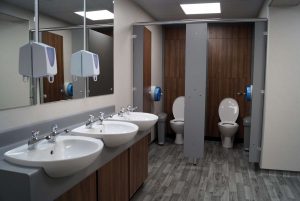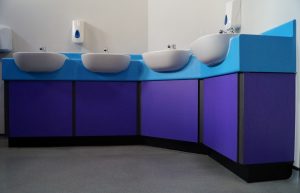School Toilet Refurbishment Materials Explained
With different products on the market this is school toilet refurbishment materials explained from my experience of running school projects. Below is what I would recommend to any school that is looking to refurbish their toilets.
Running My First Large Project
During the summer holiday of 2021 I was the sole contract manager of my first larger project. The project was at a School and involved the refurbishment of individual toilets, a cleaner’s cupboard and storage rooms into a large open female toilet and individual male toilet.
Toilet refurbishments are one of my favourite types of projects to be involved with due to the vast improvement it can make to a school. Due to this I decided to look into the different materials used within cubicles, rear ducting and vanity units and the benefits and drawbacks of using them.
Three Types of Materials Used in Toilet Refurbishments
There are 3 main materials used to create the bright and colourful cubicle systems used in schools and commercial buildings:
Melamine Faced Chipboard (MFC)
Firstly is MFC which is the cheapest option. However this is due to the material which is only recommended to be used in areas with low use i.e. a small restaurant or office where the toilets do not have continuous use. This material can easily be damaged and wear very quickly if in constant use or if it is not cleaned correctly. This is because of moisture left on the face for a period of time can eventually soak through into the chipboard below resulting in it swelling and the faces to bubbling and peeling off.
Once this has occurred there is no way to reverse it so the only option is for it to be replaced. For certain customers this option may be viable, however as a company we never use this material as we want to guarantee longevity for all of our projects.
High Pressure Laminate (HPL)
HPL, like MFC, is made from moisture resistant chipboard but instead of a melamine face it is produced using a high-pressure laminating process. This produces a much more water-resistant laminate face and matching lipping compared to MFC. This material is built to withstand regular and even intense usage meaning that it can be used in almost any location no matter the size. However, due to the fact that the core material is still chipboard it is not recommended to use in an environment where the material is likely to be regularly wet such as a leisure centre.
Water and urine will not soak through the laminate but it will possibly get into the chipboard along the edges between the lipping and face which can then cause the bubbling and peeling effect which means the material is ruined. As a company we use only HPL for our vanity unit tops as the material can actually be shaped creating a curved, clean and slick look compared to a traditional box detail.
Solid Grade Laminate (SGL)
Finally is SGL and this is the most durable material by a long way and is almost indestructible! It is extremely strong and fully water resistant and can be used in any location lasting for a very long time without looking dated. This is the main material we use for our toilet refurbishments as it does not matter if water gets onto the material and is left. It is extremely durable and hard to damage and can just be wiped clean proving ideal for any type of use from leisure centres to main school toilets. SGL comes in many bright and funky colours that can lighten any toilet block.
For examples of school toilet refurbishment projects we have recently completed, please click on the following link to our toilet case studies section of our website https://www.wallerservices.com/casestudies-construction-details/toilet-refurbishment/










